MICROSCOPE-ANTIQUES.COM © 2013-20.
The Microscope of Antoni van Leeuwenhoek (Boerhaave Museum Replica)
In Use: circa 1668-1723
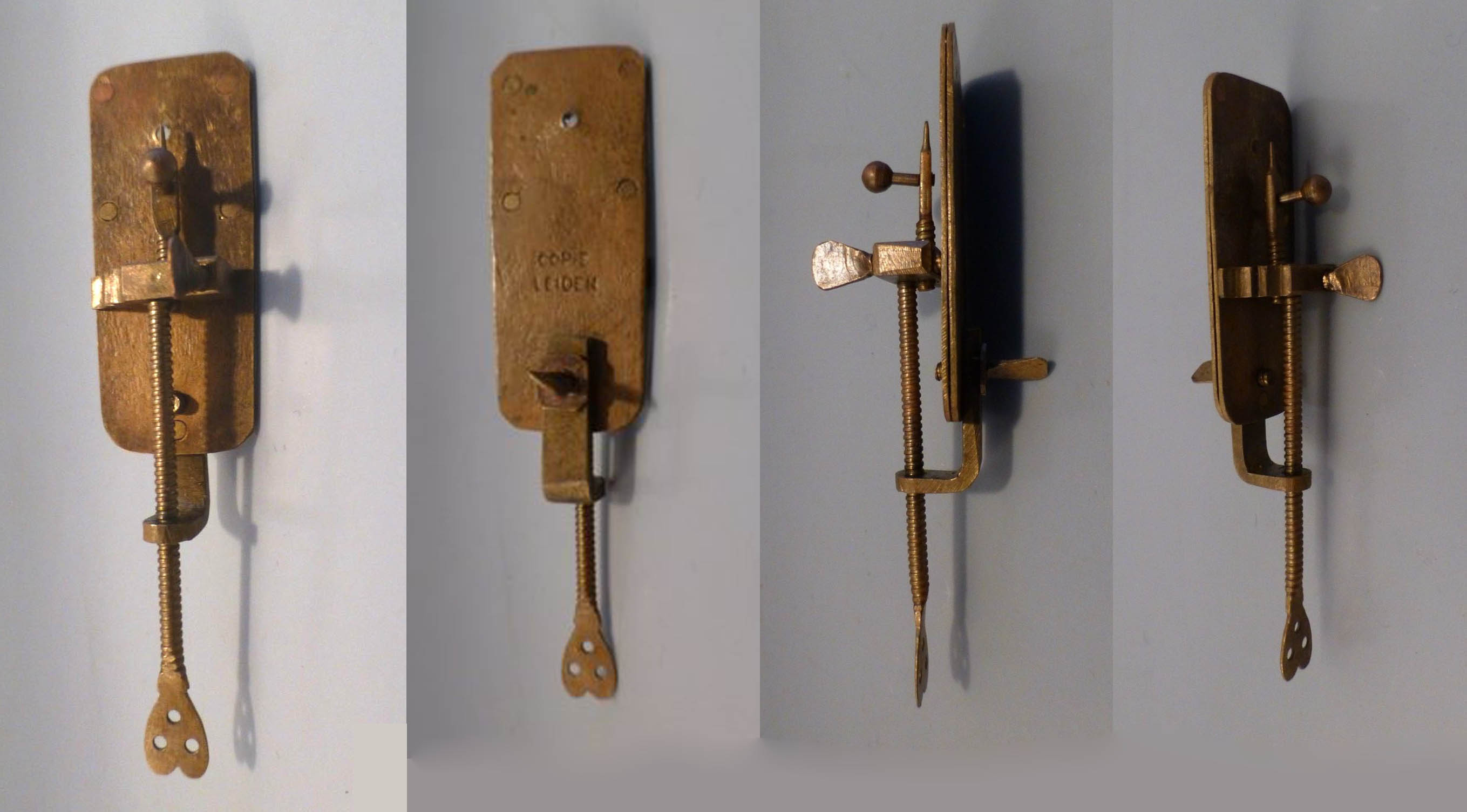
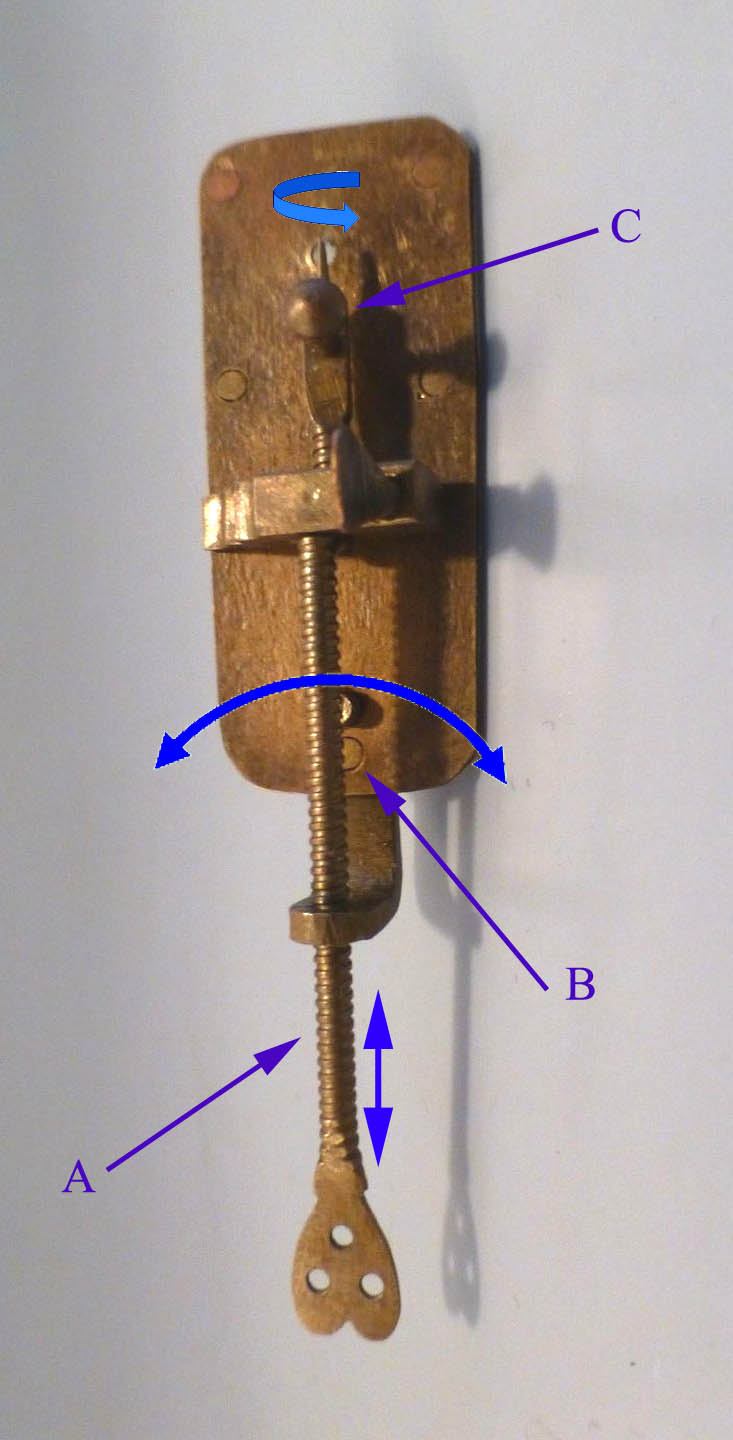
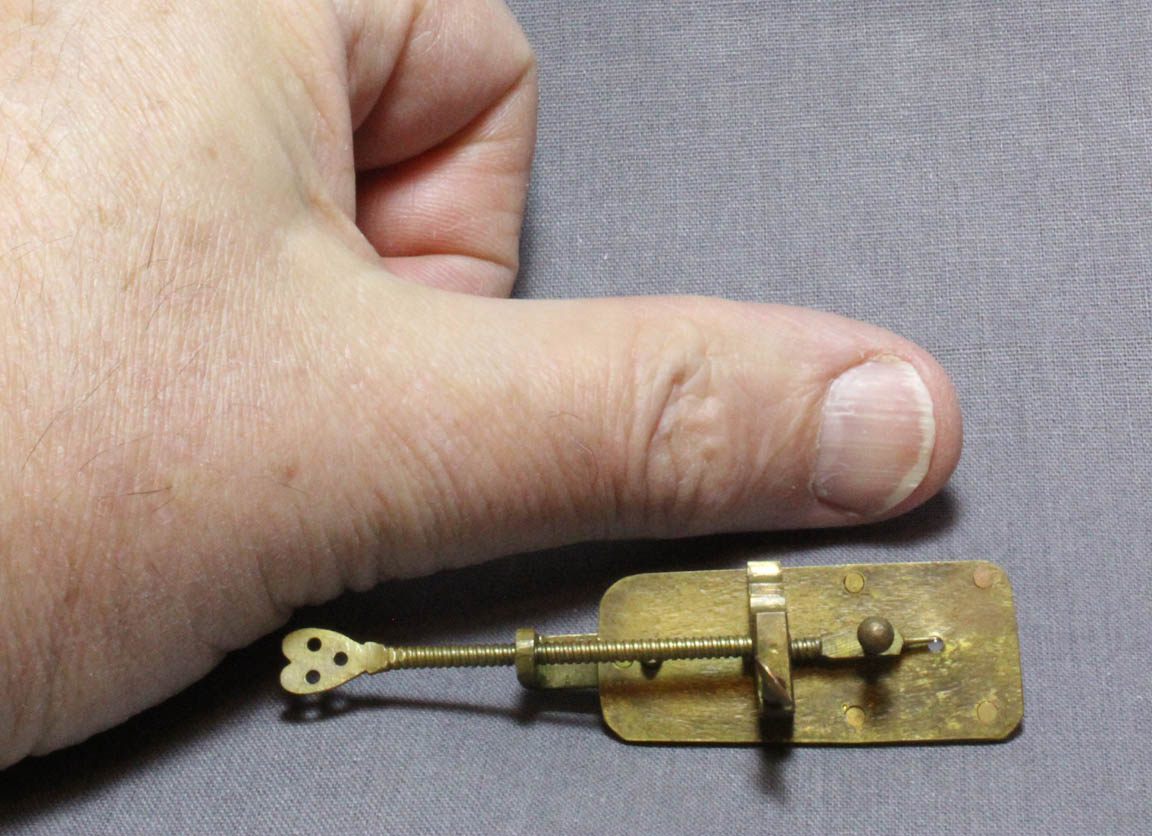
 Antoni van Leeuwenhoek, the greatest microscopist of his time, perhaps of all time, constructed microscopes nearly identical to that shown here. This replica was made by the Boerhaave Museum in Leiden which has made these for many years. Recently they changed to reproduce a different form. This example was copied from the original Haaxmann microscope in their collection. It is made of brass, like most of van Leeuwenhoek's microscopes, though he also made many of them out of silver and a very few of gold. It is stamped on one side 'COPIE, LEIDEN'. The rectangular plates measure only about 41 x 17mm. The plates are each about half a mm thick. This is not very different than the size of my thumb. It consists of two thin brass plates, between which is sandwiched a small, single spherical round high-power lens. (Occasionally he made microscopes with two or even three different powers, an example with three different powers is shown in the portrait seen below on this page). The lens is held in place by dimples on each plate. The plates are held together by six rivets. The rest of the microscope consists of a simple attachment to hold the specimen. The long thrumbscrew(A) controls vertical motion of the specimen held on the pointed spike at the top. The horizontal movement is in an arc with its axis at the lower end of the instrument(B). Finally the spike can rotate via a tiny knob(C). The specimen can therefore be partially rotated. The threads of the long screw of this microscope were custom made to match that of the original-unlike most reproductions, it is not a standard thread. The finish on this microscope, like the surviving examples by van Leeuwenhoek himself, has an oxidized brass patina. In use, the microscope must be held very close to the eye. Since it is held in the hand, one must be able to hold it steady and have reasonably good eyesight to be able to use it to full advantage. Although van Leeuwenhoek's microscopes ranged from about 40 to over 250 power, this one is in the lower range, perhaps 100X. There is some indirect evidence that he made some microscopes of over 400 power, though none of these highest power instruments are extant. This particular microscope is a copy of one of the so-called Haaxman microscopes; only three microscopes have a provenance tracing them directly back to van Leeuwenhoek. Dirck Haaxman being a direct descendent of van Leeuwenhoek was the the seller in 1743 after the death of van Leeuwenhoek's daughter. There are about ten other original microscopes which have been attributed to van Leeuwenhoek, mainly through circumstantial evidence (see below). This microscope came with a fine plexiglass display case; the case measures 112 x 61 x 48 mm. The back is quite heavy, and is 20 mm thick.
Antoni van Leeuwenhoek, the greatest microscopist of his time, perhaps of all time, constructed microscopes nearly identical to that shown here. This replica was made by the Boerhaave Museum in Leiden which has made these for many years. Recently they changed to reproduce a different form. This example was copied from the original Haaxmann microscope in their collection. It is made of brass, like most of van Leeuwenhoek's microscopes, though he also made many of them out of silver and a very few of gold. It is stamped on one side 'COPIE, LEIDEN'. The rectangular plates measure only about 41 x 17mm. The plates are each about half a mm thick. This is not very different than the size of my thumb. It consists of two thin brass plates, between which is sandwiched a small, single spherical round high-power lens. (Occasionally he made microscopes with two or even three different powers, an example with three different powers is shown in the portrait seen below on this page). The lens is held in place by dimples on each plate. The plates are held together by six rivets. The rest of the microscope consists of a simple attachment to hold the specimen. The long thrumbscrew(A) controls vertical motion of the specimen held on the pointed spike at the top. The horizontal movement is in an arc with its axis at the lower end of the instrument(B). Finally the spike can rotate via a tiny knob(C). The specimen can therefore be partially rotated. The threads of the long screw of this microscope were custom made to match that of the original-unlike most reproductions, it is not a standard thread. The finish on this microscope, like the surviving examples by van Leeuwenhoek himself, has an oxidized brass patina. In use, the microscope must be held very close to the eye. Since it is held in the hand, one must be able to hold it steady and have reasonably good eyesight to be able to use it to full advantage. Although van Leeuwenhoek's microscopes ranged from about 40 to over 250 power, this one is in the lower range, perhaps 100X. There is some indirect evidence that he made some microscopes of over 400 power, though none of these highest power instruments are extant. This particular microscope is a copy of one of the so-called Haaxman microscopes; only three microscopes have a provenance tracing them directly back to van Leeuwenhoek. Dirck Haaxman being a direct descendent of van Leeuwenhoek was the the seller in 1743 after the death of van Leeuwenhoek's daughter. There are about ten other original microscopes which have been attributed to van Leeuwenhoek, mainly through circumstantial evidence (see below). This microscope came with a fine plexiglass display case; the case measures 112 x 61 x 48 mm. The back is quite heavy, and is 20 mm thick.
HISTORY:
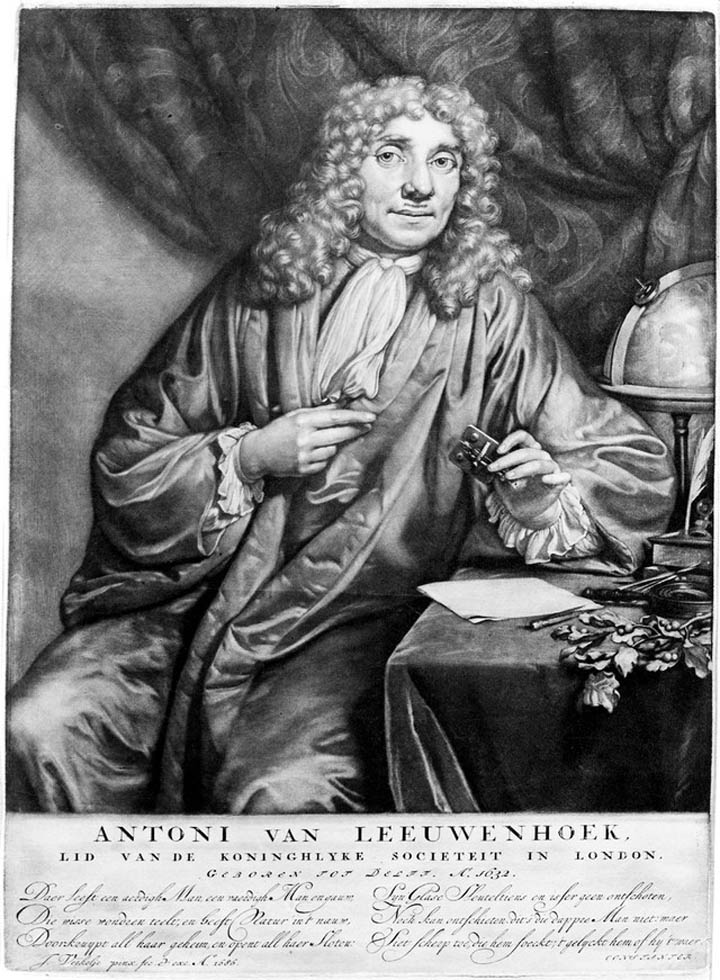 Antoni van Leeuwenhoek (left) was born in the City of Delft in the Dutch Republic (commonly now referred to as Holland in English-speaking countries, but officially the Netherlands), in October of 1632. At the age of 16 he became a bookkeeper's apprentice in a draper's* shop in Amsterdam, owned by a Scottish man, William Davidson. There he was highly regarded and respected, even at that young age and was quickly given a high level of responsibility in the shop. The trade of Draper* was to
be his future occupation, leading to him owning his own Draper shop in Delft in the middle of the 1600's. He was a very intelligent man and was appointed to several posts after being certified as a surveyor, including Chamberlain of the
Sherriff's office, Surveyor, and Wine-Gauger all in Delft. These
occupations provided income so he could continue his passion of being a microscopist.
Antoni van Leeuwenhoek (left) was born in the City of Delft in the Dutch Republic (commonly now referred to as Holland in English-speaking countries, but officially the Netherlands), in October of 1632. At the age of 16 he became a bookkeeper's apprentice in a draper's* shop in Amsterdam, owned by a Scottish man, William Davidson. There he was highly regarded and respected, even at that young age and was quickly given a high level of responsibility in the shop. The trade of Draper* was to
be his future occupation, leading to him owning his own Draper shop in Delft in the middle of the 1600's. He was a very intelligent man and was appointed to several posts after being certified as a surveyor, including Chamberlain of the
Sherriff's office, Surveyor, and Wine-Gauger all in Delft. These
occupations provided income so he could continue his passion of being a microscopist.
It is unknown when van Leeuwenhoek made his first high power microscope, but he is known to have had one when he visited England in 1668. His first letter concerning microscopical observations was published by the Royal Society in 1673. He was elected a Fellow of the Royal Society in 1680. He continued to write letters to that society until he died in 1723. Over 120 of his letters were published. It has been assumed that van Leeuwenhoek became familiar with single lens magnifiers as a Draper who would need to inspect the threads of cloth with such a device. There is no proof of that however, and his lenses were of much greater power than would be used for inspection of cloth. In fact, as pointed out by Brian Ford, Hooke described a similar microscope long before van Leeuwenhoek made one. It may be that Hooke's book was the inspiration for van Leeuwenhoek, since his microscope so resembles the simple device first described by Hooke.
Whatever the impetus, the quality and power of his lenses, his innate talent and keen powers of observation, led van Leeuwenhoek to a large number of incredibly important discoveries, including the discovery of the shape and correct size of red blood cells, the existence of protozoa, the existence of spermatatozoa,
the existence of bacteria, and the fine structure of countless additional animal, plant, and mineral subjects. Most of his microscopes had a single lens of a power suitable for study of the object being studied, but several had two lenses of different powers, and at least one had three, as shown in the portrait above.
When one examines one of van Leeuwenhoek's microscopes, one immediately notes how tiny they are. How could he use such a small microscope and why not make it larger? A partial answer is seen in portraits of him, which uniformly show fingers which are quite petit for an adult male. His fingers were very thin, thus making it easier for him to manipulate small objects and the small controls on his microscopes. I have estimated the diameter of his fingers to be about half of mine!
It has been said (on Wikipedia among other places) that van Leeuwenhoek made his lenses of beads of glass through a melting process. This has been proven false-all of his surviving lenses have
been examined by experts and all but one were ground, not blown or made of unground melted beads. Just one of his lenses may have been made through a blowing technique. Van Leeuwenhoek's single lenses were able to resolve things that compound microscopes of the time could never resolve. This is because both spherical and chromatic aberration were greatly worsened in such compound instruments. Although a high power single-lensed ("simple") microscope is harder to use than the compound,
its useful limit of magnification was always higher until the development of achromatic and aplanatic lens of the 1830's or
so. This optical superiority is part of what allowed the Genius of Delft to make such impressive discoveries. The other reason he was able to make such discoveries is, ironically, the fact that he had no preconceptions, and no formal scientific training, which until then, was often flawed and not based on scientific evidence. With a clear mind uncluttered by misleading opinions of philosophical scientists (as opposed to experimentalists), and great intelligence, he was able to form objective conclusions.
Although van Leeuwenhoek did not invent the microscope, he was the first to use high power single lenses to make important and revolutionary scientific discoveries.
Of interest, although van Leeuwenhoek made over 500 microscopes, only about a dozen or so are now known to exist, although two previously unrecognized examples were discovered in 2015. Among those still missing are some 26 made of silver and sent to the Royal Society, only to be missing some years later; two were also in the possession of Queen Mary II, likewise unaccounted for. Of the two recovered in 2015, one was found in canal dredgings near van Leeuwenhoek's former home in Delft. Another was found in a collection of silver doll-house miniatures in Holland. Replicas abound, so it may take a world class expert to authenticate any new finds. Even then, there may be doubt, because it would be worthwhile for a forger to use extreme effort to make a replica that appears authentic.
In regard to the construction and authenticity of real
van Leeuwenhoek microscopes, only the three 'Haaxman' examples are absolutely certain to be made by van Leeuwenhoek. The other known examples are regarded to be by him based on circumstantial evidence. This includes the fact that historical replicas of microscopes were generally not constructed prior to the mid-19th century. Thus when a similar microscope was discovered and could be traced back further, it was reasonable to conclude it was not a replica. This concept was apparently quite convincing, as many 19th and 20th century, and even 21st century replicas were copied from a wider (and better known), example in the Utrecht University Museum. That example has fewer rivits and its attribution to van Leeuwenhoek is mainly based on its age. An example similar to a microscope in the University of Utrecht is in this collection, as is a another brass replica similar to another example in the Boerhaave which is slightly different than the one on this page above. In years past, the Utrecht model was the one most frequently copied, most famously by Mayall. Unlike those however, the one on this page is copied from one of the Haaxman microscopes at the Boerhaave, which in my humble opinion, makes it a more reliable representation of van Leeuwenhoek's work.
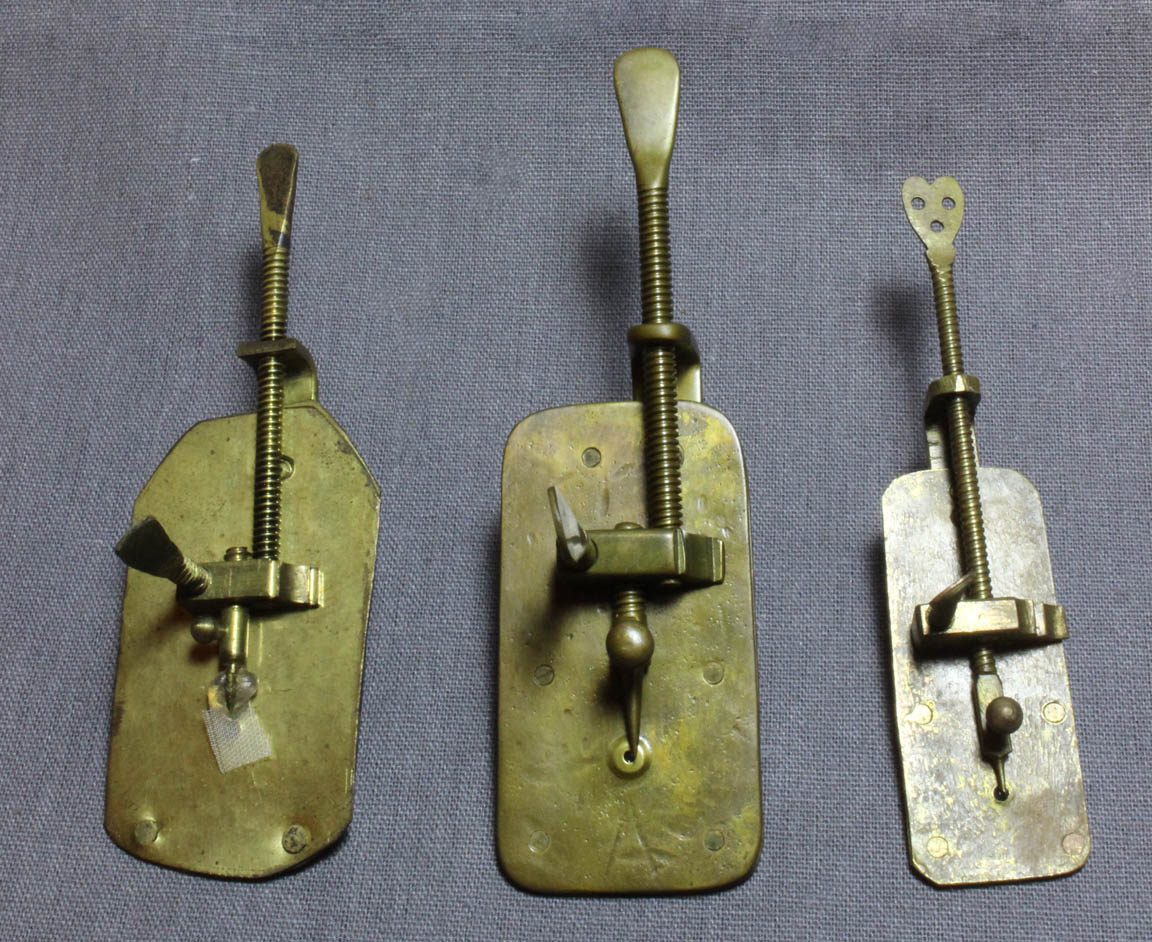
Three replicas of van Leeuwenhoek's microscopes from this collection. Far left is a replica made by the author many years ago from a kit. The middle example, by Christopher Allen Replicas was made in 2015. For comparison, the Haaxman replica by the Boerhaave is shown to the right; note that it is a bit narrower than the others. My example assembled from a kit has a small piece of cloth attached to the point.
*A Draper is a seller of cloth used to make clothing.
References:
1. Beads of Glass: Leeuwenhoek and the early microscope, edited by Dr Brian Bracegirdle, published by the Museum Boerhaave, 1983
2. www.lensonleeuwenhoek.net
3. What Were the Missing Leeuwenhoek Microscopes Really Like?,Ford, Brian J. Proc Roy Microscopical Soc. 18 118-124. 1983.



 Antoni van Leeuwenhoek, the greatest microscopist of his time, perhaps of all time, constructed microscopes nearly identical to that shown here. This replica was made by the Boerhaave Museum in Leiden which has made these for many years. Recently they changed to reproduce a different form. This example was copied from the original Haaxmann microscope in their collection. It is made of brass, like most of van Leeuwenhoek's microscopes, though he also made many of them out of silver and a very few of gold. It is stamped on one side 'COPIE, LEIDEN'. The rectangular plates measure only about 41 x 17mm. The plates are each about half a mm thick. This is not very different than the size of my thumb. It consists of two thin brass plates, between which is sandwiched a small, single spherical round high-power lens. (Occasionally he made microscopes with two or even three different powers, an example with three different powers is shown in the portrait seen below on this page). The lens is held in place by dimples on each plate. The plates are held together by six rivets. The rest of the microscope consists of a simple attachment to hold the specimen. The long thrumbscrew(A) controls vertical motion of the specimen held on the pointed spike at the top. The horizontal movement is in an arc with its axis at the lower end of the instrument(B). Finally the spike can rotate via a tiny knob(C). The specimen can therefore be partially rotated. The threads of the long screw of this microscope were custom made to match that of the original-unlike most reproductions, it is not a standard thread. The finish on this microscope, like the surviving examples by van Leeuwenhoek himself, has an oxidized brass patina. In use, the microscope must be held very close to the eye. Since it is held in the hand, one must be able to hold it steady and have reasonably good eyesight to be able to use it to full advantage. Although van Leeuwenhoek's microscopes ranged from about 40 to over 250 power, this one is in the lower range, perhaps 100X. There is some indirect evidence that he made some microscopes of over 400 power, though none of these highest power instruments are extant. This particular microscope is a copy of one of the so-called Haaxman microscopes; only three microscopes have a provenance tracing them directly back to van Leeuwenhoek. Dirck Haaxman being a direct descendent of van Leeuwenhoek was the the seller in 1743 after the death of van Leeuwenhoek's daughter. There are about ten other original microscopes which have been attributed to van Leeuwenhoek, mainly through circumstantial evidence (see below). This microscope came with a fine plexiglass display case; the case measures 112 x 61 x 48 mm. The back is quite heavy, and is 20 mm thick.
Antoni van Leeuwenhoek, the greatest microscopist of his time, perhaps of all time, constructed microscopes nearly identical to that shown here. This replica was made by the Boerhaave Museum in Leiden which has made these for many years. Recently they changed to reproduce a different form. This example was copied from the original Haaxmann microscope in their collection. It is made of brass, like most of van Leeuwenhoek's microscopes, though he also made many of them out of silver and a very few of gold. It is stamped on one side 'COPIE, LEIDEN'. The rectangular plates measure only about 41 x 17mm. The plates are each about half a mm thick. This is not very different than the size of my thumb. It consists of two thin brass plates, between which is sandwiched a small, single spherical round high-power lens. (Occasionally he made microscopes with two or even three different powers, an example with three different powers is shown in the portrait seen below on this page). The lens is held in place by dimples on each plate. The plates are held together by six rivets. The rest of the microscope consists of a simple attachment to hold the specimen. The long thrumbscrew(A) controls vertical motion of the specimen held on the pointed spike at the top. The horizontal movement is in an arc with its axis at the lower end of the instrument(B). Finally the spike can rotate via a tiny knob(C). The specimen can therefore be partially rotated. The threads of the long screw of this microscope were custom made to match that of the original-unlike most reproductions, it is not a standard thread. The finish on this microscope, like the surviving examples by van Leeuwenhoek himself, has an oxidized brass patina. In use, the microscope must be held very close to the eye. Since it is held in the hand, one must be able to hold it steady and have reasonably good eyesight to be able to use it to full advantage. Although van Leeuwenhoek's microscopes ranged from about 40 to over 250 power, this one is in the lower range, perhaps 100X. There is some indirect evidence that he made some microscopes of over 400 power, though none of these highest power instruments are extant. This particular microscope is a copy of one of the so-called Haaxman microscopes; only three microscopes have a provenance tracing them directly back to van Leeuwenhoek. Dirck Haaxman being a direct descendent of van Leeuwenhoek was the the seller in 1743 after the death of van Leeuwenhoek's daughter. There are about ten other original microscopes which have been attributed to van Leeuwenhoek, mainly through circumstantial evidence (see below). This microscope came with a fine plexiglass display case; the case measures 112 x 61 x 48 mm. The back is quite heavy, and is 20 mm thick.  Antoni van Leeuwenhoek (left) was born in the City of Delft in the Dutch Republic (commonly now referred to as Holland in English-speaking countries, but officially the Netherlands), in October of 1632. At the age of 16 he became a bookkeeper's apprentice in a draper's* shop in Amsterdam, owned by a Scottish man, William Davidson. There he was highly regarded and respected, even at that young age and was quickly given a high level of responsibility in the shop. The trade of Draper* was to
be his future occupation, leading to him owning his own Draper shop in Delft in the middle of the 1600's. He was a very intelligent man and was appointed to several posts after being certified as a surveyor, including Chamberlain of the
Sherriff's office, Surveyor, and Wine-Gauger all in Delft. These
occupations provided income so he could continue his passion of being a microscopist.
Antoni van Leeuwenhoek (left) was born in the City of Delft in the Dutch Republic (commonly now referred to as Holland in English-speaking countries, but officially the Netherlands), in October of 1632. At the age of 16 he became a bookkeeper's apprentice in a draper's* shop in Amsterdam, owned by a Scottish man, William Davidson. There he was highly regarded and respected, even at that young age and was quickly given a high level of responsibility in the shop. The trade of Draper* was to
be his future occupation, leading to him owning his own Draper shop in Delft in the middle of the 1600's. He was a very intelligent man and was appointed to several posts after being certified as a surveyor, including Chamberlain of the
Sherriff's office, Surveyor, and Wine-Gauger all in Delft. These
occupations provided income so he could continue his passion of being a microscopist. 